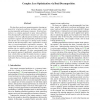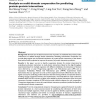80 search results - page 2 / 16 » How to predict very large and complex crystal structures |
BMCBI
2006
13 years 5 months ago
2006
Background: When accurate models for the divergent evolution of protein sequences are integrated with complementary biological information, such as folded protein structures, anal...
BMCBI
2008
13 years 5 months ago
2008
Background: Prediction of transmembrane (TM) helices by statistical methods suffers from lack of sufficient training data. Current best methods use hundreds or even thousands of f...
CVPR
2012
IEEE
11 years 7 months ago
2012
IEEE
We describe a novel max-margin parameter learning approach for structured prediction problems under certain non-decomposable performance measures. Structured prediction is a commo...
BMCBI
2007
13 years 5 months ago
2007
Background: Domains are the basic functional units of proteins. It is believed that protein-protein interactions are realized through domain interactions. Revealing multi-domain c...
BMCBI
2005
13 years 5 months ago
2005
Background: Molecular profiling generates abundance measurements for thousands of gene transcripts in biological samples such as normal and tumor tissues (data points). Given such...


